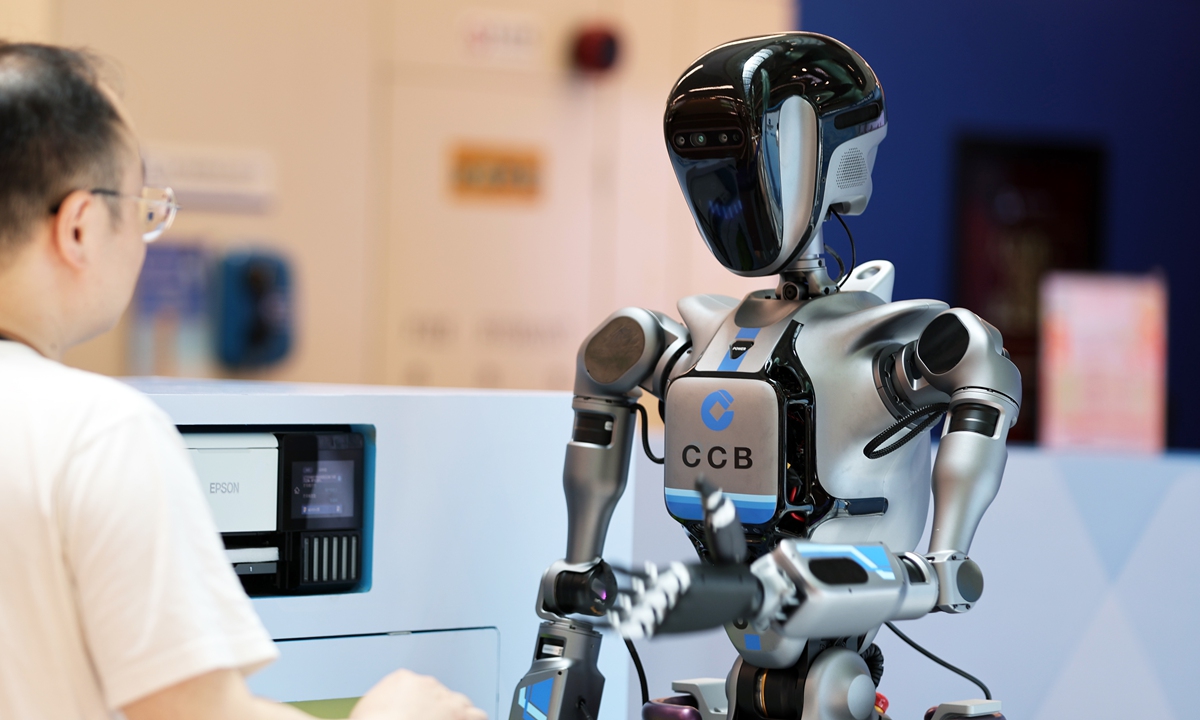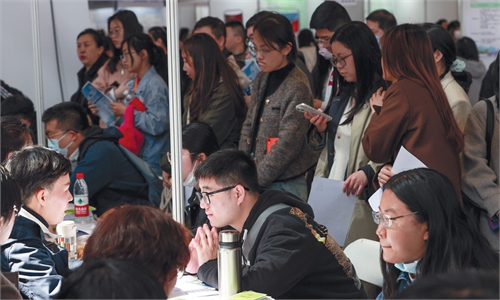19 fresh professions released in China to keep pace with demand of new quality productive forces

An engineer trains an intelligent humanoid robot to work as a bank lobby manager in Shanghai on July 16, 2024. This kind of robot is equipped with artificial intelligence technologies such as vision, hearing and speech. The robot has already been trained in bank lobby business consultations, among other functions. Photo: VCG
China has released 19 fresh professions to keep pace with demand of new quality productive forces, according to the Ministry of Human Resources and Social Security (MHRSS) on Wednesday. Observers said that the new professions hint that job seekers should be more open to adjust to the changing environment. Also, young elderly (generally referring to age between 65 and 74) who are well educated can explore the possibility of transitioning into a career in digital and intelligent technologies as a way to adapt to the ageing society.
The 19 new professions include cloud-based intelligent operations and maintenance personnel, generative artificial intelligence system application staff, and user growth operation specialists, as well as 28 new job categories such as live recruitment specialists. These new jobs have been included in the National Occupational Classification (NOC).
The emergence of new professions reflects the new changes and trends in China's economic and social development, meeting the new needs of production and life, and providing laborers with more employment choices.
Over half of the 19 new professions released are closely related to new quality productive forces. Among them are generative artificial intelligence system application staff, intelligent connected vehicle testers, intelligent manufacturing system maintenance personnel, and industrial internet operations and maintenance personnel.
Other new positions nurtured by the digital economy are online anchors and user growth operation specialists.
The release of the new occupations came at a moment when the governments and social forces are pouring in policies to stabilize employment, and rolling out more targeted policies to boost employment.
In June, the country's surveyed urban unemployment rate stood at 5 percent, with the employment situation remaining generally stable, according to the MHRSS.
China has set an annual target of creating more than 12 million new urban jobs this year. It also aimed to keep the surveyed urban jobless rate at around 5.5 percent this year.
Observers said that with the upgrading of digital technology and the continuous development of society in recent years, a number of new occupations have been approved by the state and are appearing more and more around us. These new occupations offer job seekers direction and more options.
The ministry said China will continue efforts to foster new employment growth in areas such as advanced manufacturing and the digital economy, and provide more assistance to key groups, including college graduates and migrant workers.
The increasing of new professions has also provided clues on how to live better in the ageing society, especially for the young elderly.
"Digital and intelligent technologies have reduced the labor intensity of positions, thereby increasing the possibility of employment for the elderly," Yuan Xin, deputy head of the China Population Association and a demographer from Nankai University, told the Global Time on Wednesday.
People need to actively adapt and realize that we are already in a moderately ageing society. Currently, the average life expectancy of Chinese people has reached over 78 years. For the younger elderly who are in good health and well-educated, they are able to adapt to new job opportunities if they voluntarily embrace delaying their retirement so that they have longer period of time to create wealth, the demographer said.
The new occupations included within the NOC are not newly created jobs but those occupations that are not included in the classification, but already have a certain scale of practitioners and require relatively independent and mature professional skills.
According to the MHRSS, "green" is another major label for these new professions. There are already 134 green professions marked in the NOC, accounting for 8 percent of the total number of professions.
Many of these newly included professions stem from the new needs of economic transformation and green low-carbon development, such as hydrogen-based direct reduction ironworkers originating from traditional industries, energy storage station maintenance administrators and power quality administrators to meet the development of emerging industries.


